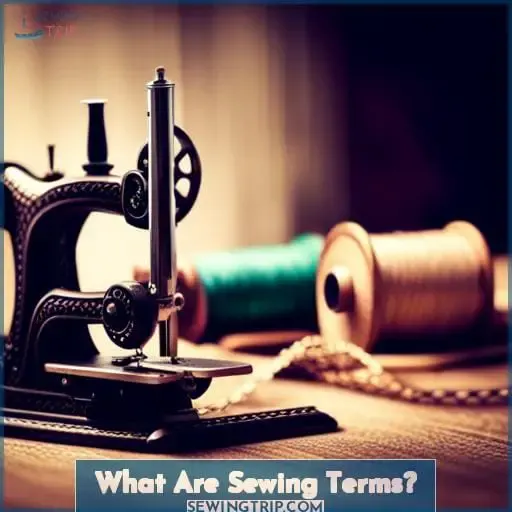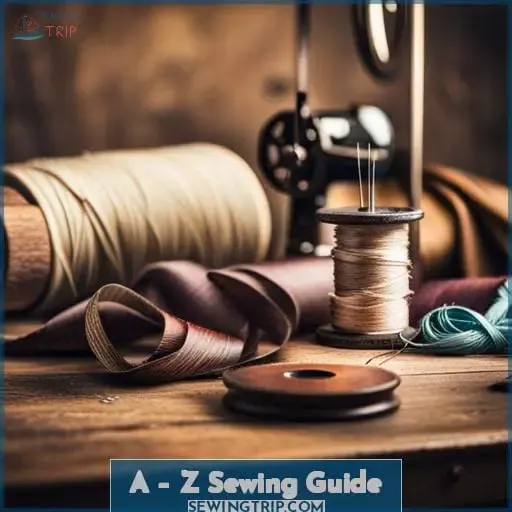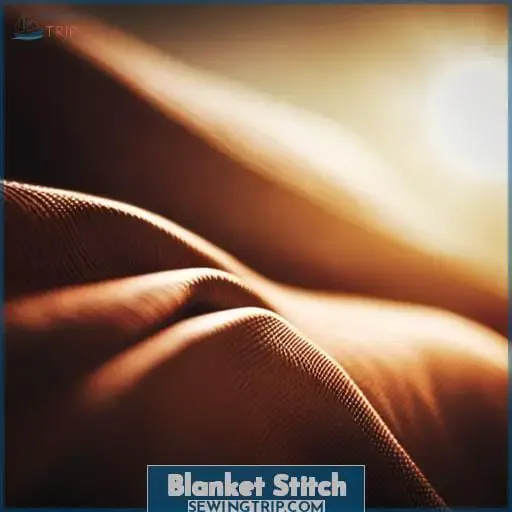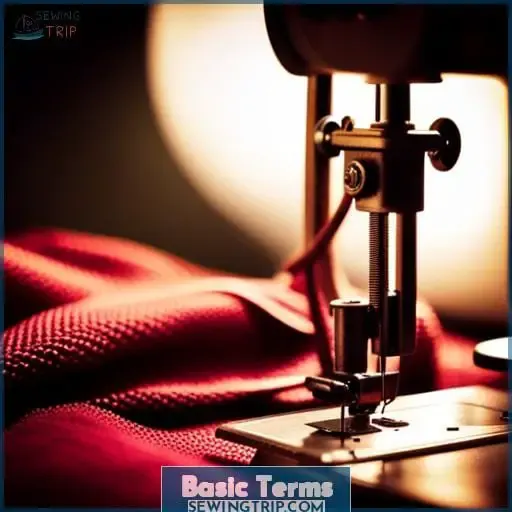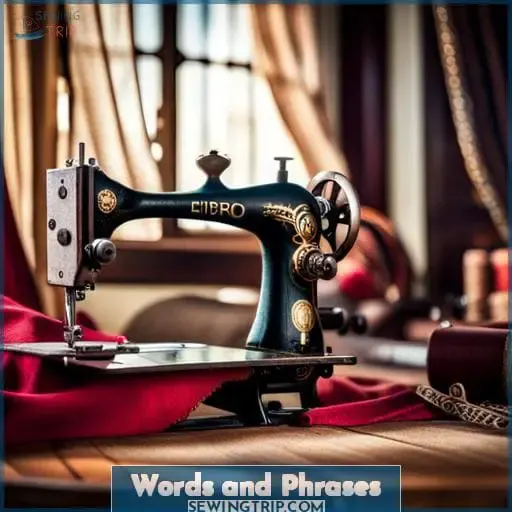This site is supported by our readers. We may earn a commission, at no cost to you, if you purchase through links.
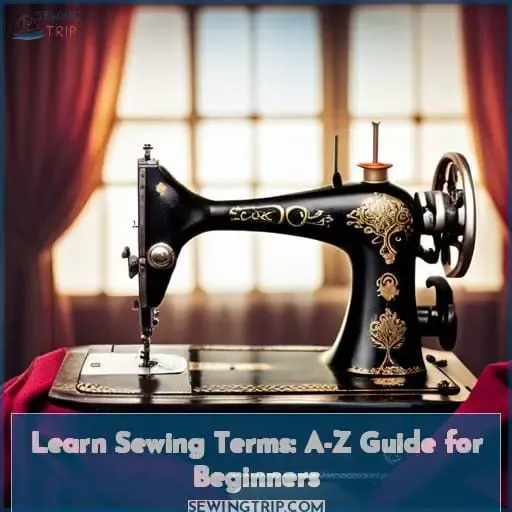 Are you finding yourself lost in a maze of unfamiliar sewing terminology? When folks bandy about words like ‘darts,’ ‘ease,’ and ‘seam allowance,’ do you nod along blankly? As a beginner sewer, it’s completely normal to feel overwhelmed by the vocabulary.
Are you finding yourself lost in a maze of unfamiliar sewing terminology? When folks bandy about words like ‘darts,’ ‘ease,’ and ‘seam allowance,’ do you nod along blankly? As a beginner sewer, it’s completely normal to feel overwhelmed by the vocabulary.
But having the right lingo empowers you to understand patterns, ask questions, and gain mastery over this craft.
That’s why we’ve created the ultimate A to Z guide defining essential sewing terms. With this knowledge, you’ll speak the language fluently. From ‘backstitch’ to ‘selvage,’ you’ll discover what key phrases mean so nothing gets lost in translation.
Sewing has a learning curve, but understanding the fundamentals accelerates your progress tremendously. Our guide unlocks the secrets so you can not only follow instructions but also express your creativity.
With the special vocabulary demystified, you can sew fearlessly. Your new knowledge is the thread that will connect the dots on your sewing journey.
Table Of Contents
Key Takeaways
- Unfamiliar sewing terms can overwhelm beginners.
- Sewing vocabulary covers stitches, seams, tools, and measurements.
- Proper fabric and stabilizer selection prevents tension issues.
- Threading the sewing machine properly is crucial.
What Are Sewing Terms?
You’re stitching together the patchwork of language to assemble the garment of sewing knowledge. Sewing terminology forms a specialized vocabulary that empowers crafters to precisely communicate techniques.
Understanding terms for stitches, seams, tools, and measurements enables confident sewing. Choose compatible fabrics and stabilizers to avoid tension issues. Adjust presser feet, stitch length, and seam allowances based on your straight stitch or running stitch.
Thread the guide properly on your sewing machine before beginning projects. With experience, the language of sewing will become second nature.
A – Z Sewing Guide
Let’s delve into the A to Z of sewing terminology. You’ll become fluent in the language of sewing as we cover key concepts like appliqué, bias, cotton, darts, ease, and more. With practice, you’ll master specialized words that help communicate techniques.
A
What’ll Anger fabric is pulling bias alignment while cutting. Adjusting grain along crosswise edges keeps stitches smooth.
B
Bind those edges beautifully to make garments more durable.
- Match pattern pieces precisely for professional results.
- Choose natural fibers like cotton and linen for comfort.
- Sharp, fine needles pierce fabric cleanly.
- Decorative stitches add flair and interest.
- Follow fabric care instructions to prevent damage.
Sew thoughtfully and skillfully for satisfaction.
C
Stand near the tailor’s chalk as you trim the muslin’s raw edges, then pin the trial garment, ensuring ample ease. Master straight stitches, zig-zags, and overlocking to secure seams, interfacing, and fabric finishes.
Stitching techniques require proper tools – needles, thread, machines – for creative expression.
D
Darts define shapes through directional stitching. You determine the draping of fabric for dimension. Strategically placed darts sculpt garments to fit your form as you transfer precise pattern markings onto fabric with tailor’s chalk.
E
Embellish your project with embroidered designs to add personalized flair. Notch and dart garments, then press seams flat. Align pieces and stitch carefully. Finish edges with bias facings. Insert zippers neatly using a zipper foot.
Blanket Stitch
You likely know that clipping inner corners prevents bulk, and that clipping outer curves reduces puckering, but terms like dart, dressmaker dummy, and ease may need some clarification. While a dart is a stitched fold that shapes a garment, a dressmaker dummy is a 3D mold used for draping and fitting, and ease refers to the roominess built into a pattern for comfort and movement.
Clip Corners
You’ll neatly clip corners before turning your project right side out for a professional finish.
- Snip diagonally at seam allowances
- Avoid cutting stitching
- Helps fabric lay flat around curves
Clipping inner corners prevents puckering, ensuring smoothly turned projects with crisp edges.
Clip Curves
Snip those waves before they overwhelm your ocean of calm. Freeform fabric demands strategic clipping along curves. Ensure proper grain line alignment first. Then carefully notch inward, taking care not to clip too deeply.
This prevents puckering and ripples when stitching darts or rounded seams. Now press forward smoothly.
Dart
Taper the fabric to shape garments with precise darts. Eliminate gaps and enhance fit by tucking and folding the fabric along the grain. Master precise shaping with simple folds that gather fabric for curve-hugging style.
Dressmaker Dummy
Put on the unfinished dress and stand in front of your adjustable dressmaker dummy to check the fit. Your faithful companion is like an extra fitting room, allowing you to refine the tailored contours before adding facings or lining fabric.
Assess the drape and hang while selecting perfectly matching thread colors for the woven fabrics.
Ease
You’ll need to build in some ease into the garment so it doesn’t bind up when you move. Princess seams and dart manipulation shape the garment while allowing ease for comfort. Align fabric grain properly so seams don’t twist. Finish seams to prevent fraying.
Selvage edges aid alignment. Cross-stitch for decoration, zigzag for versatility.
The Fundamental Terms and Phrases
As you advance in your sewing skills, you’ll encounter more fundamental terms and phrases to integrate into your knowledge base. Fine-tuning the fit of garments involves altering patterns – moving darts, adjusting seam allowances, and accounting for the grainline.
Fabric selection requires knowing the right and wrong sides, along with the selvage edges. Pattern drafting from scratch demands a solid grasp of measurements. Hand sewing builds familiarity with needles and thread.
Seam allowances provide wiggle room between stitching and raw edges. The grainline keeps pattern pieces aligned properly.
Immerse yourself in the language of sewing for a deeper understanding that leads to more professional results and creative freedom with each new project.
Basic Terms
-
The grain line refers to the main direction of the threads in a piece of fabric. Following the grain is important for achieving proper fit and drape.
-
The selvage edge is the tightly woven finished edge along the sides of fabric. It helps prevent fraying and raveling.
-
The right side of a fabric is the outer side that will be visible. The wrong side will face inward.
-
A cutting mat provides an even surface with guidelines to cut fabric smoothly and accurately. It protects your work surface too.
Familiarizing yourself with fundamental vocabulary is key as you build expertise. With practice, terms like fusible interfacing, hooks and eyes, long stitch, and tailor’s chalk will become second nature too.
Though sewing has precise techniques, creative freedom exists within the well-defined rules.
Fabric Terms
When discussing fabric terms, understand that grain direction impacts how fabric hangs and stretches. Cutting fabric on the bias versus the straight grain creates very different results. Bias-cut fabric drapes well and has stretch, while cutting on the straight grain minimizes stretch.
Match the grain to the garment design. Finish your seams well, pressing them open or closed as needed. Leave ample seam allowance, especially on curves. Finish fabric edges with facings or bindings. Turn up hems, pressing well. Utilize the selvage edge when possible. Knowing these fabric properties empowers sewing success.
Words and Phrases
You’re in for a treat as we dive into the fun lingo that makes sewing so enriching.
Notions like thimbles protect digits when hand-sewing, while others like seam rippers undo mistakes.
Knowledge of stitching techniques empowers creativity, from versatile zigzags to decorative cross stitches.
Comprehending garment construction unlocks mastery, from darts that shape to sleeves set into armscyes.
Measurement tools like tape measures ensure precision, while fabric preparation with selvages and seam allowances enables success.
Other fabric terms like batting provide padding, while tools like presser feet hold layers steady.
Finally, slip stitches inconspicuously join folded edges for invisible seaming.
Sewing vocabulary enlightens and liberates.
Do You Want to Learn Basic Starting Tools for Sewing?
Let’s get you equipped with essential tools to start sewing up creativity. First, ensure proper seam allowance with a ruler and chalk. Master thread tension using the numbered dial. Press as you go with a pressing cloth to prevent shine.
Set the stitch length according to the fabric weight of the project. Use a rotary cutter on a gridded mat for precision. As your crafting skills improve, add specialty feet to finish zippers or match plaids.
With practice, these beginner sewing tools empower your sewing and unlock limitless potential for expression.
Frequently Asked Questions (FAQs)
What are some tips for choosing fabric for a sewing project?
Consider fiber content, drape, and structure when selecting fabric. Let the garment design and your skills guide you. Avoid mismatches between fabric and pattern that compromise the final product. Touch and move samples to judge hand, sheen, and opacity.
How can I troubleshoot issues with my sewing machine or serger?
Check thread tension, change needle, clean lint, oil the machine, check bobbin and feed dogs, adjust presser foot pressure, test stitch on scrap fabric. If the problem persists, consult the manual or take it to a repair shop. Stay calm and methodical in your process.
What sewing books or online resources do you recommend for beginners?
I’d recommend checking out the Beginner’s Guide to Free-Motion Quilting by Natalia Bonner.
How do I start a career or business in sewing?
To launch a sewing career, gain expertise in stitching techniques, garment construction, and finishing. Embrace your creative expression through sewing, turning fabric into art, and establishing a thriving business in this empowering craft.
What advice do you have for fitting garments and adjusting patterns?
Adjusting patterns and fitting garments empowers your sewing journey. Use techniques like tissue fitting and muslin prototypes. Embrace princess seams, darts, and ease for personalized, comfortable creations.
Conclusion
After soaking up this essential sewing terminology, you’re well on your way to stitching success.
With these fundamental terms and techniques in your back pocket, you can tackle any pattern or project with poise.
Though the road from novice to master sewer is long, having command of these building blocks will serve you well.
Let your creativity soar as you make each new discovery in your sewing journey, emboldened by the vocabulary that unlocks this crafter’s paradise.
With patience and practice, you’ll be sewing up a storm in no time.
So thread your needle, grab some fabric, and immerse yourself in the language of sewing – your next masterpiece awaits!

